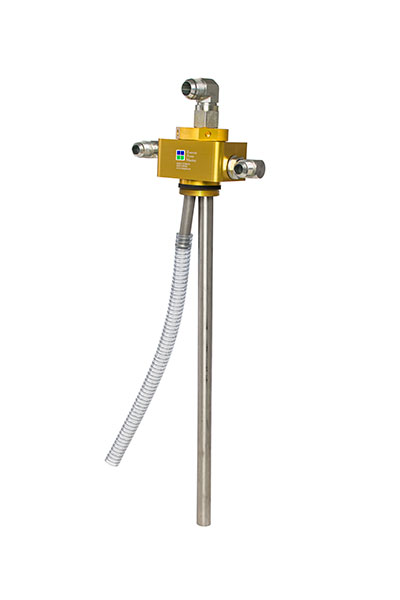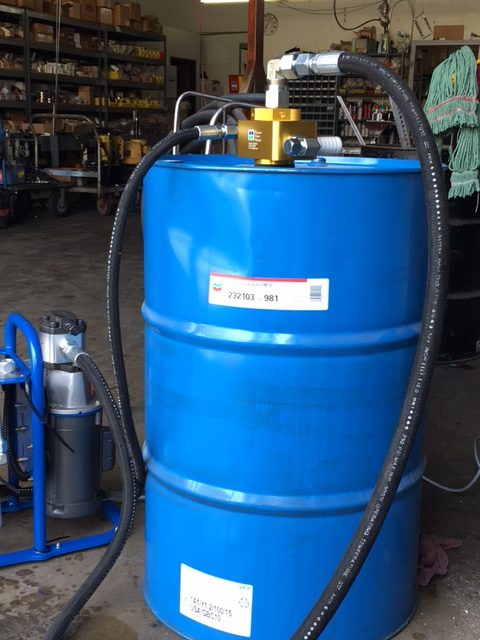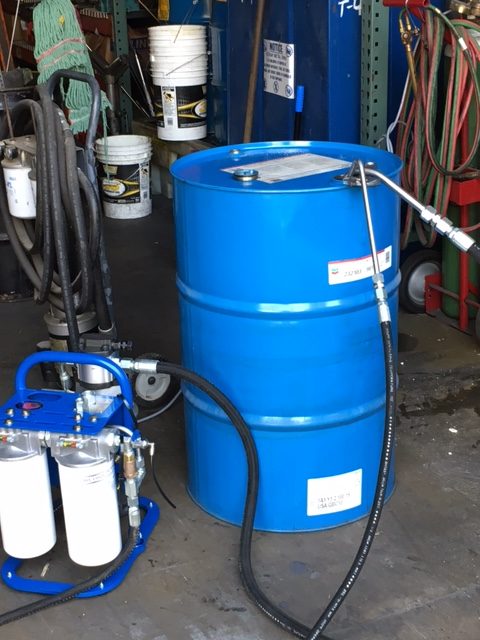When hydraulic systems need to be cleaned, there’s no easy way to access the fluid inside reservoirs. As any user of fluid power knows, new and used hydraulic fluids typically are not pre-filtered and can be highly contaminated. One-pass filtration systems aren’t enough. Opening the filler breather cap while filling the reservoir allows airborne particles and moisture to enter. Overfilling and spills are common practice, increasing environmental pollution and the risk of personal injury. Finally, draining an overfilled reservoir is problematic and hydraulic components can be damaged by over filled reservoirs.

Two models of Reservoir Access Manifolds are available, including a bolt down design, right, and ones made of two pieces, left, including a body and cartridge.

Filtering and transferring fluid to hydraulic and lube systems is typically done by inserting tube wands through the filter-breather twist cap or threaded opening on top of the tank and the oil drum or tote bungs. This method leaves reservoirs and drums open to contaminates and spills.
The (RAM) Reservoir Access Manifold from c-change offers a different, safer and cleaner solution. The RAM is an offline filtration loop adapter that allows simple access to fluids inside closed reservoirs, drums and gearboxes. With the addition of one or two internal tubes, users can add and remove fluid using the existing filter breather opening, reservoir cap, or pipe thread reservoir breather opening.

The RAM Manifold from c-change is a safe, clean offline filtration loop adapter that allows easy access to fluids inside closed reservoirs, drums and gearboxes.
Two models are available. The BD (Bolt Down) uses the standard 6-hole reservoir mount and is made of a single piece of aluminum. The DT and ST models are made of two pieces, a body and cartridge. Both have tubes that enter the interior of the reservoir and terminate below the fluid level. Both models have interconnecting passages in their bodies connecting the interior tubes to the exterior. Each has threaded ports for fitting connections
“I’ve been in the fluid power industry for 40-plus years and I’ve seen firsthand how destructive dirty oil is to component life,” said Marc Watson, Founder of c-change Inc. “The Reservoir Access Manifold, or RAM, is a new hydraulic component that mounts to your reservoir, oil drums, totes and gearboxes and will save oil, components and your money.
“The RAM gives users easy access to the oil in reservoirs, drums and totes with no fabrication,” Watson continued. “They only take minutes to install because they use the existing reservoir breather or cap. This gives you control over what enters and leaves your system. Proactive fluid management just got easier. The RAM lets you easily use a filter cart when transferring oil from drums to reservoirs. It also allows offline filtration with your system on or off while keeping systems closed to contaminants.”
The BD RAM (Bolt Down) can replace the standard filler breather and mount directly in its place. Users can remount the original bayonet cap on top of the BD or upgrade to a more efficient filter. The BD comes standard with a 1 in. female pipe thread top breather port. BD RAMs incorporate five functions in one body. Features include:
- Reservoir filler/ breather
- 1-in. positional suction tube
- ¾ in. positional return tube
- Overflow port
- Oil sampling port
The suction and return down tubes are inserted into the bottom of the BD and can be rotated 360°. Both tubes terminate below the reservoir fluid level. They can be straight or bent and positioned in the reservoir for maximum efficiency.
 An overflow passage communicates with the reservoir air gap in the event of overfilling the tank. This gives the potentially over-pressurized fluid an exhaust route, without causing damage, all while minimizing spills. Oil sampling is accomplished by using an internal flexible tube within the air breather passage which can be attached to either down tube terminating below the fluid level. Because of the stationary position, reliable oil samples may be taken with the system on or offline.
An overflow passage communicates with the reservoir air gap in the event of overfilling the tank. This gives the potentially over-pressurized fluid an exhaust route, without causing damage, all while minimizing spills. Oil sampling is accomplished by using an internal flexible tube within the air breather passage which can be attached to either down tube terminating below the fluid level. Because of the stationary position, reliable oil samples may be taken with the system on or offline.
Models DT and ST accomplish the same functions as the BD model, but without a separate sampling port, and attach to the reservoir differently. DT and ST use a male pipe thread or straight thread mounting connection and offer one or two internal down tubes. Overflow protection and a breather port is provided. The DT and ST models are designed to maximize the internal area by minimizing the internal male thread wall thickness. This reduces the choking effect of having down tubes inside the male attachment thread. The down tube sizes have been selected to maximize air flow while keeping the largest possible suction tube diameter.
A final benefit, said Watson, is reduced oil usage. RAM users can delay oil change outs and reduce system component replacements. “You will now be able to obtain and keep those ISO cleanliness codes. RAMs facilitate the greening of our industry — finally,” Watson concluded.
Learn more and see c-change at IFPE March 10-14 in the South Hall in booth S-81461.
c-change Inc.
c-changeinc.com
Filed Under: Filtration/Contamination Control, Sealing & Contamination Control Tips